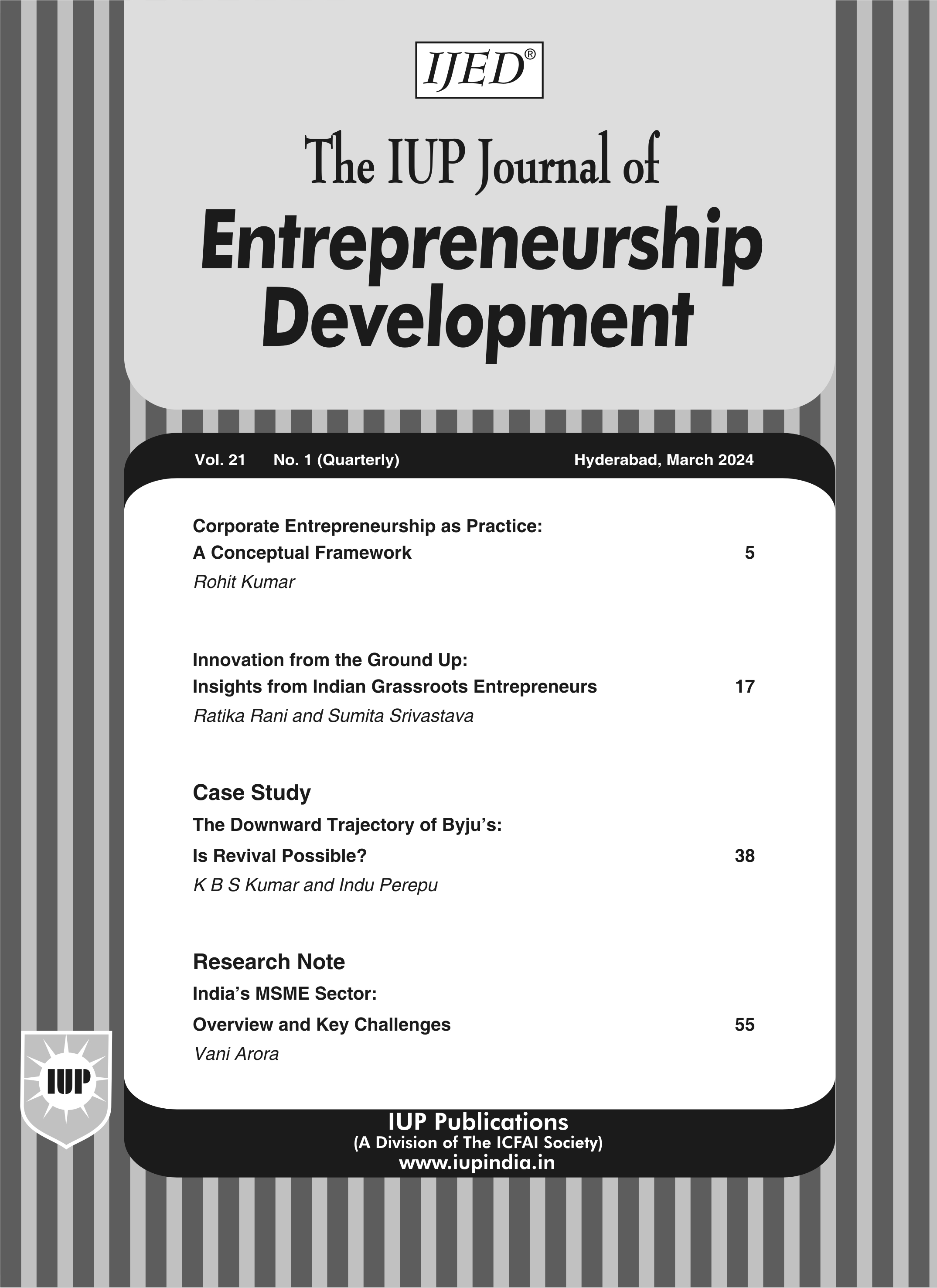
June'22
The IUP Journal of Entrepreneurship Development
Archives
Antecedents of Market Orientation and Entrepreneurial Marketing Performance in Emerging Markets
Wisdom Apedo Deku
Ph. D. Candidate, Yanshan University, School of Economics and Management Studies, China, Hebei Province,
Qinhuangdao; and is the corresponding author. E-mail: wisdomapedodeku@gmail.com
Jiuhe Wang
Professor, Yanshan University, School of Economics and Management Studies, China, Hebei Province,
Qinhuangdao City. E-mail: wjh@ysu.edu.cn
This study aims to examine the antecedents of market orientation and entrepreneurial marketing dimensions in emerging markets and their effects on the performance of SMEs in the beverages sector. Data collection was conducted in Greater Accra region through the Association of Ghana Industries (AGI) and National Board for Small Scale Industries (NBSSI). The findings revealed that Entrepreneurial Marketing Dimensions (EMDs) had a positive significant effect on SME performance. Nevertheless, market orientation, customer orientation and competitor orientation had a positive insignificant impact on the beverages sector. Besides market orientation, customer orientation and competitor orientation significantly moderate the relationship between EMDs and SME performance in Ghana as it is an emerging market. The results show that Ghana's NBSSI should increase vigorous training programs for SMEs in the beverages sector to understand customer needs and to increase their profitability, market share and sustainability in the emerging market. Also, policymakers and authorities should ensure that related government institutions as well as various stakeholders should collaborate to improve EMD and market, customer and competitor orientations within the SME industry. This study adds to the ongoing discussion on the emerging market, SMEs, Resource Base View Theory, entrepreneurship and beverages industry by providing a comprehensive overview of EMDs, market orientation, customer orientation and competitor orientation in the emerging market.
Introduction
In the Ghanaian context, Small and Medium Enterprises (SMEs) are defined and measured based on three criteria: micro, small and medium, by taking into account the number of employees and assets. Micro enterprises have less than five employees; small enterprises have fixed assets not exceeding 10 million Ghanaian Cedi with employees not more than 9; and medium enterprise have not less 10 and not more than 29 employees (Adams et al., 2017; Selase and Worlanyo, 2018; Ghana Statistical Services, 2020; and National Board for Small Scale Industries, 2020). Sadiku-Dushi et al. (2019) and Hisrich and Ramadani (2017) identified the critical success factors for SMEs in the Emerging Markets (EMs): Entrepreneurial Marketing Dimensions (EMDs): calculated risk-taking innovation-focused, proactive opportunities and orientations-market orientations, customer orientation and competitor orientation.
EMDs in EMs refer to the propensity of companies' top management to take calculated risks, remain innovation-focused and proactive, and identify opportunities in the marketplace to satisfy customers (Barbu et al., 2020; and Dulanjani and Priyanath, 2020). Market, customer and competitor orientations in EMs are the process of satisfying customer's needs by facilitating sharing of competitor information and inter-functional coordination to enhance SME performance (Deku et al, 2021 and 2022; and Dzogbenuku and Keelson, 2019). EMDs and market orientations are recognized as critical success factors to generate global competitiveness among SMEs (Alqahtani and Uslay, 2020; Adel et al., 2020 ; Adams et al., 2017; and Asante and Affum-Osei, 2019).
Some studies have been conducted globally on SME performance in EMs (Alqahtani and Uslay, 2020; Adel et al., 2020; and Abass et al., 2020) because of its usefulness to entrepreneurs, marketers and innovators, and a few of these earlier studies have examined the relationship between EMDs and SMEs in the beverages sector (Selase and Worlanyo, 2018; Dzogbenuku and Keelson, 2019).
The purpose of this study is to investigate the impact of EMDs-innovation-focused, pro- active, opportunity-driven and calculated risk-taking of SMEs-on beverages sector in EMs. The objective of the study is to examine the relationship between EMDs and SMEs and how beverages sector correlated with market, customer and competitor orientation in the emerging markets.
This study contributes to the literature on emerging markets, SMEs, entrepreneurship and Resources Based View (RBV) theory. This study contributes to RBV theory by using market, customer and competition orientations as a moderating variable on the relationship between EMD and beverages sector in EMs.
Resource-Based View Theory
The RBV theory is based on the major sources of firm performance in the rapidly changing EMs (Deku et al., 2021; and 2022). Importantly, RBV is one of the theories used in entrepreneurship, which advocates that organizations should act rationally to scan the business environment for opportunities, coordinating human and material resources, to accomplish performance in EMs (Ahmed et al., 2017). According to RBV theory, risk-taking, pro-activeness and innovativeness by SMEs in EMs to develop new products and services and be ahead of competitors in anticipation of expected future needs of customers are influenced by the firm's resource-based view (Ahmed et al., 2017).
RBV is widely used in marketing and entrepreneurship literature but is rarely applied to EMD and market operations of SMEs in emerging market (Ali et al., 2018; and Battour
et al., 2019). Researchers (Ahmed et al., 2017; and Jourdan, 2002) have criticized RBV. According to Battour et al. (2019, the theory did not provide a theoretical framework for explaining any dimension. For Jourdan (2002), the theory is not based on behavioral theories to determine how dimensions can be integrated to create a unified brand. According to Ahmed et al. (2017), the theory does not focus on process and end goals, but only on outcome goals.
Despite all this criticism (Deku et al., 2022) have authenticated the theory with arguments that the theory is more contextual and critically rare. To address the challenges of knowledge gap identified in RBV, EMD and EMs were conceptualized as the measurement pillars. This study presents the RBV in the context of market, customer and competition orientations in EMs and as effective, efficient, innovative roadmaps for SMEs resource allocation.
Literature Review and Hypotheses Formulation
Entrepreneurship of SMEs in Emerging Markets
Entrepreneurship SMEs activities in EMs of Ghana have been with mankind since the medieval days contributing significantly towards survival and wellbeing of humanity globally. Entrepreneurship in EMs of Ghana reflects how a firm's strategic attitude produces entrepreneurial practices and behaviors in achieving business objectives (Cho and Lee, 2018; Deku et al., 2022; and Tseng and Tseng, 2019).
Entrepreneurship SMEs in Africa contribute about 45% of total jobs, and 33% towards GDP (OECD, 2019; and Selase and Worlanyo, 2018). SMEs in Ghana as EMs represent about 92% of operational businesses and contribute about 70% of Ghana's GDP (BfT, 2020). The recognition of entrepreneurship of SMEs in Ghana has served as the backbone of its economy (Asante and Affum-Osei, 2019; and Dzogbenuku and Keelson, 2019). Adams et al. (2017) argued that entrepreneurship of SMEs in the emerging markets has characteristic features of production landscape which contributes about 85% of manufacturing and 35.7% service employment in Ghana.
Entrepreneurship of SMEs in Ghana is characterized by labor intensive, low value-added sectors, low wages, owner-manager, limited formal education, lack of modern technologies, poor management skills and credit facilities from banks (Adams et al., 2017; and Deku et al., 2021). Entrepreneurship of SMEs in Ghana facilitate production, distribution, industrial innovation, and economic regeneration (Adams et al., 2017). Dzogbenuku and Keelson (2019) found that entrepreneurship of SMEs have positive links with economic growth, poverty alleviation in Ghana through innovation, creativity and human resource development. Adams et al. (2017) discovered that the necessity of entrepreneurship of SMEs in Ghana help harness the potential of human capital, promote economic growth and serve as the basis for private sector-led growth.
H1: Emerging markets have a significant relationship with SME performance.
Entrepreneurial Marketing Dimensions in Emerging Markets
Dzogbenuku and Keelson (2019) defined entrepreneurial marketing dimensions as a process, practice, decision-making activity that leads to unexploited market opportunities. EMDs in EMs refer to the willingness of a firm to be innovative to rejuvenate market offerings; take risks to try out new and uncertain products, services and markets; and be more proactive than competitors toward new marketplace opportunities (Deku et al., 2022; and Peterson, 2020).
EMDs in EMs refer to the degree to which a firm engages in and embraces new ideas, novelty, experimentation and creativity that may lead to new products, markets, services or processes (Kalaichelvi and Suganthi; 2020; Dzogbenuku and Keelson, 2019). It also refers to bold moves into unknown business areas and the commitment of significant resources to business activities under conditions of uncertainty. Abass et al. (2020) argued that EMDs have a positive impact on company performance.
Adel et al. (2020); Kalaichelvi and Suganthi (2020); Mahrous et al. (2020); and Peterson (2020) found that EMDs have a positive impact on company performance.
H2: Entrepreneurial marketing dimensions have a significant relationship with SME performance in emerging markets.
Markets, Customer, Competitor Orientation in Emerging Markets
Market, customer and competitor orientations in EMs represent a wonderful mix of the world's fastest growing developing segment with a growing middle to high income class (Awan and Kraslawski, 2019). Market, customer and competitor orientations in EMs have witnessed increasing economic growth leveraged on market liberalization plus relatively growing economic infrastructure (Peterson, 2020). It is therefore not surprising that EMs like Brazil, Russia, India, China and South Africa (BRICS) are blazing the trail by attaining rapid socioeconomic growth, creating jobs for the growing unemployed, and creating wealth for daring investors operating in this unique market (Dzogbenuku and Keelson, 2019; and Mahrous et al., 2020).
In Sub-Saharan Africa, countries like Botswana, Ghana, Ethiopia, Kenya, Rwanda and South Africa are making giant leaps in the midst of challenging socioeconomic and political conditions (Dzogbenuku and Keelson, 2019; and Kalaichelvi and Suganthi, 2020). To cope with the economic, political and sociocultural challenges, entrepreneurs and marketers are required to reconfigure and appreciate the power of EM principles to drive competition, sustainability, novel customer strategies that benefit stakeholders. Ayuso and Navarrete (2018), and Deku
et al. (2021) posit that most EMs of Africa are associated with the sale and use of unbranded products and poor packaging and branding due to the absence of superb marketing strategy.
Literature further confirms that most SMEs in EMs of Africa are limited in terms of market heterogeneity, stable political regime, poor market insight, and lack of essential infrastructure such as electricity, water, appropriate entrepreneurial technology and healthcare (Kalaichelvi and Suganthi, 2020). Again, African countries, including Ghana have diverse demographics, unique sociocultural values, high illiteracy and poor regulatory laws which affect EMDs and the market, customer and competitor orientations negatively. EMDs and market, customer and competitor orientations remain a fertile area for groundbreaking and developmental thoughts to benefit humanity and ultimately customers (Ayuso and Navarrete, 2018; Fard and Amiri, 2018; and Kalaichelvi and Suganthi, 2020).
H3: Market, customer and competitor orientations have a significant relationship with SME performance in emerging markets.
Data and Methodology
The study was conducted based on a questionnaire adopted from previous studies in the field of EMDs and market, customer, and competitor orientations. The data was collected between May and August 2020 and the questionnaires were sent by post to the SMEs listed on the Ghana National Board for Small Scale Industries (NBSSI).
Judgmental sampling technique was used in this study. Judgment sampling comprises the selection of subjects who are most favorably placed to provide the required information (D'Agostino, 2017). To use judgmental sampling, a list of SMEs in Ghana was drawn from NBSSI, 2020. From the total estimated number of over 25,000 SMEs, the selection was made for beverages industry with an estimated total number of 1000 companies.
Out of the total listing for beverages industry from the NBSSI directory, SMEs were shortlisted to finalize 550 companies. Shortlisting of judgmental sampling was based on prior discussions and advice from personnel in charge of SME development in various organizations of NBSSI.
The population of this study (Table 1) comprises managerial level staff of SMEs in the beverages sector in Ghana. For the purpose of the study, data collection was conducted in Greater Accra region of Ghana because of the cluster of beverages industries. The rest of the regions were excluded in the survey to ensure quality work, to control the delivery cost of questionnaires and to save time for data collection.
All categories of SMEs, including micro, small and medium companies, in the beverages sector are included for the purpose of this study. A total of 550 questionnaires were distributed, out of which 432 were found valid, which is 85.1% response rate
The questionnaire consists of two parts. The first part consists of 25 items of EMDs, market, customer and competitor orientations, and SME performance. The second part of the questionnaire includes the demographic section related to respondents' background, consisting of seven items (a total of 33).
A seven-point Likert scale was used to measure the three categories of structures, namely, EMDs, market, customer and competitor orientations, and SME performance. For EMDs and market, customer and competitor orientations, the scales ranged from "1" strongly disagree to "7" strongly agree. For SME performance, the scales ranged from "1" much worse to "7" much better.
In this study, the EMDs-innovativeness, proactiveness and risk-taking-were measured by adapting indicators suggested by Becherer et al. (2012) and D' Agostino (2017). Market, customer, competitor orientations and inter-functional coordination were adapted from Becherer et al. (2012) and D'Agostino (2017). SME performance indicators were adapted from Becherer (2012).
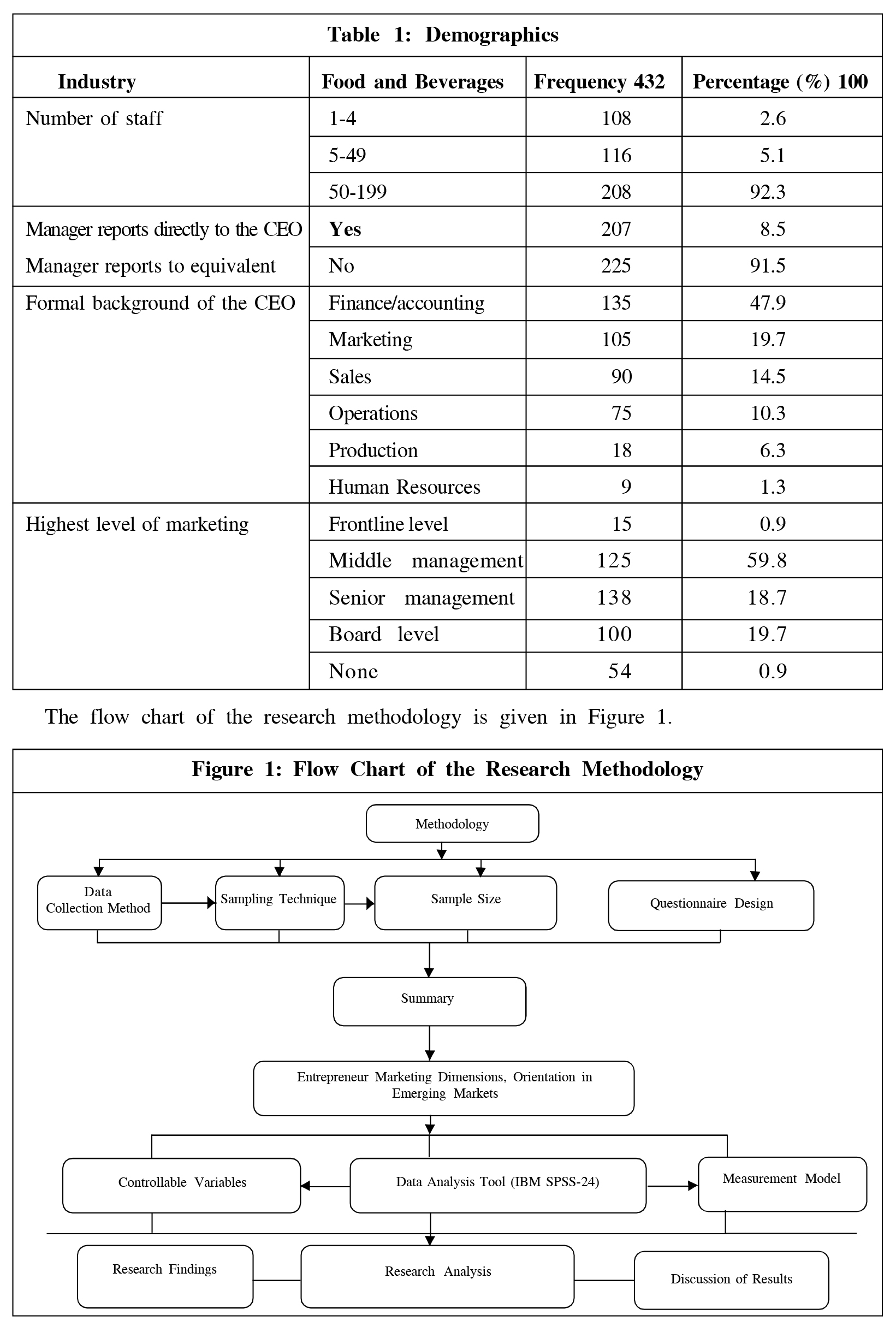
The flow chart of the research methodology is given in Figure 1.
Descriptive Statistics
Descriptive statistics was used to provide an overview of the respondents' company background, year of foundation, regional affiliations, and number of employees. The average scores for EMDs, market, customer and competitor orientations, and SME performance are 4.877, 5.189 and 3.658, respectively.
Control Variables of the Study
There are 5 control variables included in this study-SME size, SMEs age, gender, ownership and educational background. All have been used in previous research on EMDs and business performance. Natural logarithm of each SME total assets was used to measure SME size. The year of foundation or establishment reflects SME age. Gender is a categorical variable coded as 1 for male and 2 for female; ownership is a categorical variable coded as 1 for private and 2 for public SMEs; and educational background was categorized as first degree, masters and Ph.D. degree.
Data Analysis
To test the data, the study used IBM SPSS.24 second-generation multivariate technique
(Fornell and Larcker, 1981; and Kline, 2015) which can simultaneously evaluate the measurement and the structural equation model with the aim of minimizing the error variance (Fornell and Larcker, 1981; and Kline, 2015). IBM SPSS.24 (Fornell and Larcker, 1981; Kline, 2015) was used to analyze the data and 432 samples to determine the significance levels for loadings, weights and path coefficients data. Common method variance data was collected via self-reported questionnaires, through NBSSI and, in particular, both the predictor and criterion variables were obtained from the same person (Fornell and Larcker, 1981; Kline, 2015). Fornell and Larcker (1981) and Kline (2015) also noted: "Invariably, when self-reported measures obtained from the same sample are utilized in research, concerns over same-source bias or general method variance arise". One of the common methods used to detect this issue is the Harman's single factor test. This is done by entering all the principal constructs into a principal component factor analysis (Fornell and Larcker, 1981; and Kline, 2015). Evidence method bias exists when a single factor emerges from the factor analysis, or one general factor accounts for the majority of the covariance among the measures (Fornell and Larcker, 1981; and Kline, 2015). In the analysis, the results returned a six-factor solution, with a total variance of 72.962% explained and the first factor only explained 32.46%, which confirms that common method bias is not a serious problem in this study.
Measurement Model of the Study
Convergent validity is the degree to which multiple items to measure the same concept are in agreement. As suggested by (Fornell and Larcker, 1981; and Kline, 2015), the study used the factor loadings, Composite Reliability (CR) and Average Variance Extracted (AVE) to assess convergent validity. The recommended values for loadings are set at 0.5, the AVE should be 0.5 and the CR should be 0.7. From Figure 2, it can be seen that we have conceptualized EMD and MO as second-order constructs. Table 2 shows that the results of the measurement model exceeded the recommended values, thus indicating sufficient convergence validity.
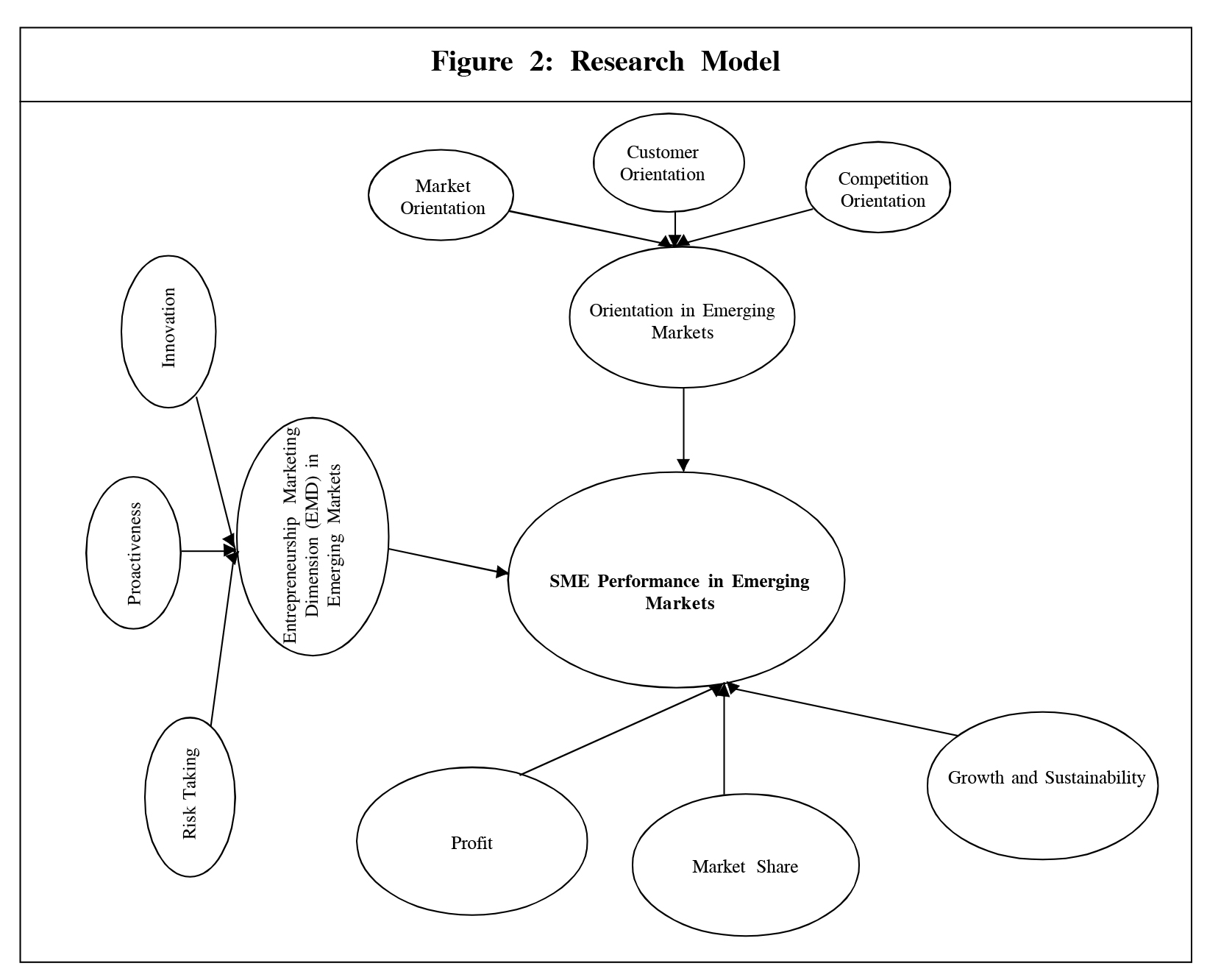
After confirming the convergent validity, the study proceeded to assess the discriminant validity using the Fornell and Larcker (1981) method. Discriminant validity is the degree to which items differentiate among constructs or measure distinct concepts. As shown in
Table 3, the study used the second method which is to compare the square root of the AVE with the correlations. From Table 3, it can be seen that the values in the diagonals are greater than the values in their respective row and column, thus indicating that the measures used in this study are distinct, demonstrating adequate discriminant validity.
Structural Equation Modeling (SEM) is used to evaluate the structural models' 'predictive power, and calculated 5E2. 5E2 indicates the amount of variance explained by the exogenous variables (Fornell and Larcker, 1981; and Kline, 2015). All three variables together explained 69.3% of the variance. Using a SEM with a re-sampling of 432, the path estimates and t-statistics were calculated for the hypothesized relationships.
Table 4 shows the structural model analysis. From the analysis, it was found that EMD (b = 0.745, p < 0.01) was positively related to (MO) (b = 0.516, p < 0.01) was positively related to SME performance. Next, the study tested the mediating effect of MO in the EMD-to-MO relationship. The bootstrapping procedure was used which has been suggested in the literature to test the indirect effect, and the results show that the indirect effect (b = 0.384, p < 0.01) was significant, indicating that there was a mediating effect. As suggested by Fornell and Larcker (1981) and Kline (2015), the study calculated the variance.
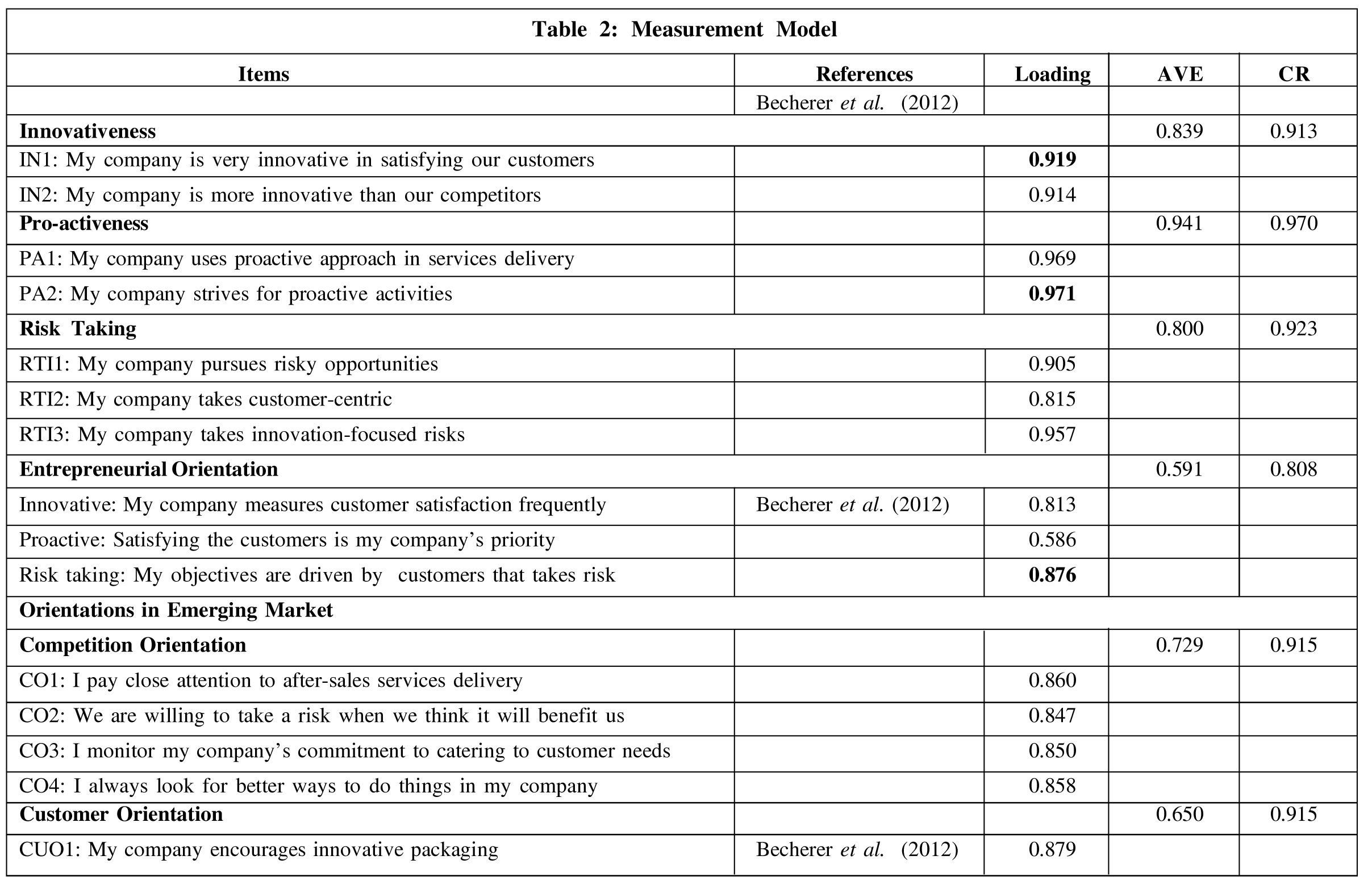
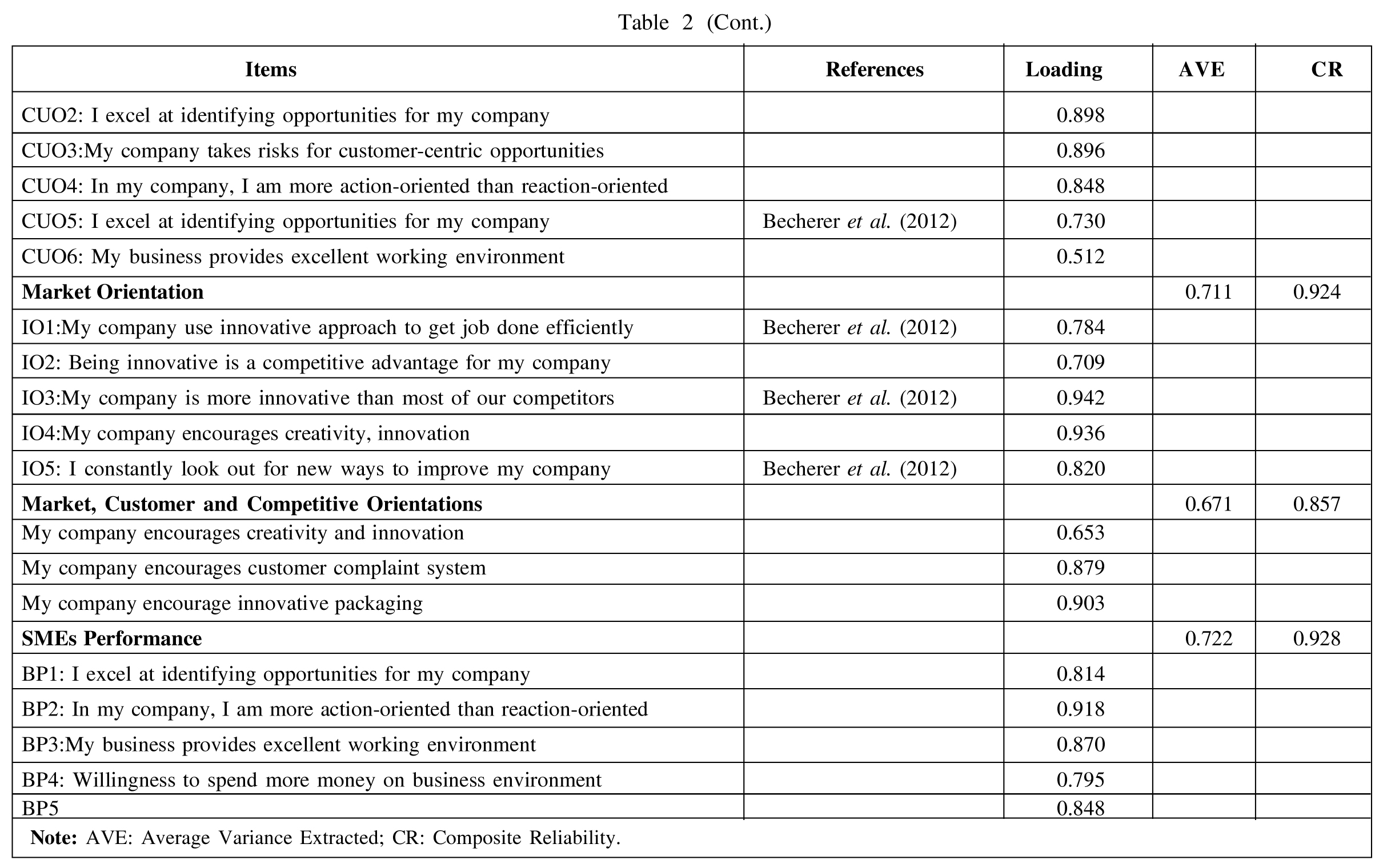
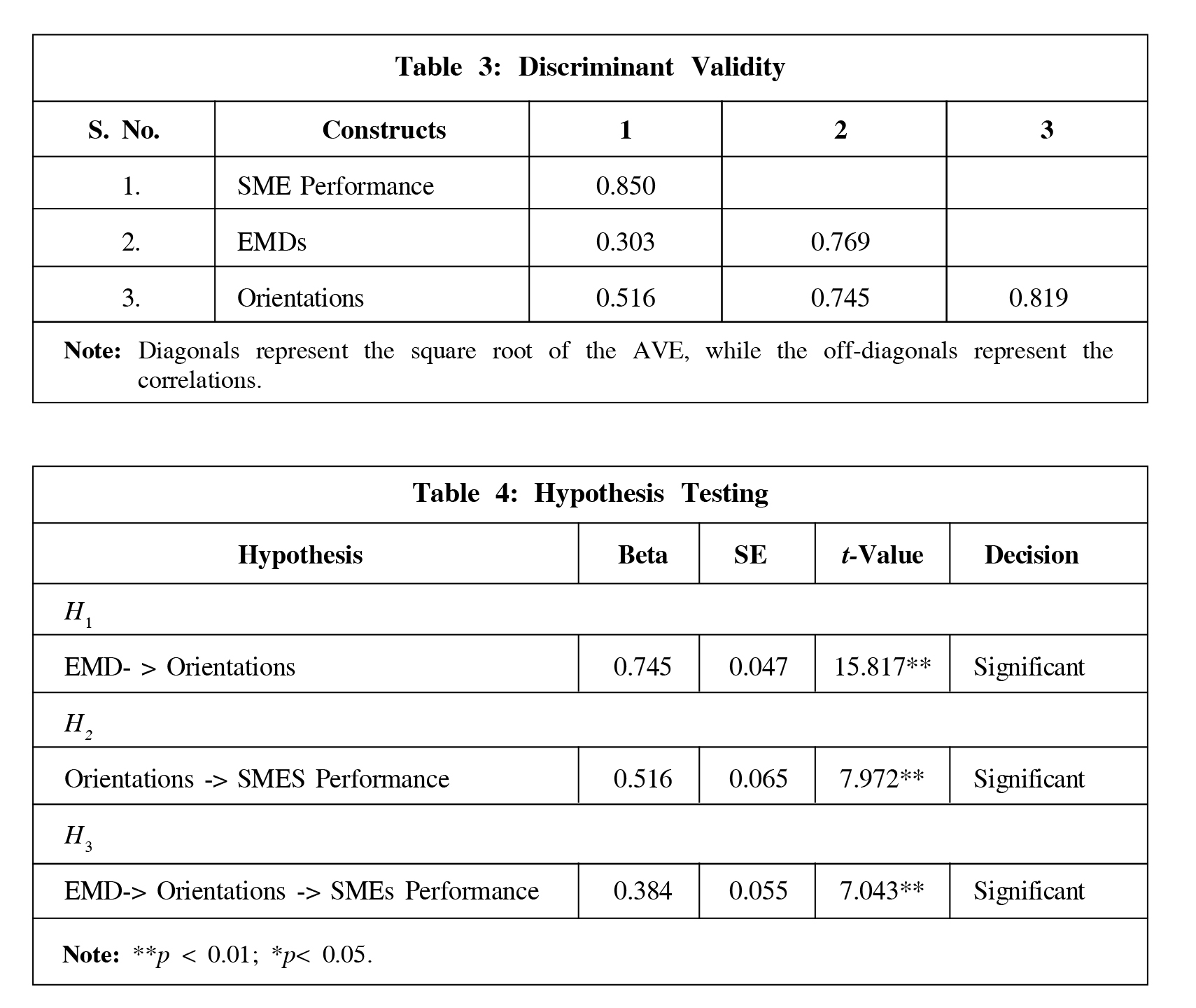
The VAF determines the size of the indirect effect in relation to the total effect (i.e., direct effect + indirect effect): VAF = indirect effect/total effect. VAF was calculated for this study and it was 0.71, which is classified as partial mediation (Fornell and Larcker, 1981; and Kline, 2015).
Results
The objective of this study is to examine the impact of EMDs on SME performance in emerging markets. The results of this study (Table 5) found that emerging market has a significant relationship with SME performance; thus, H1 was supported. This finding is consistent with Ayuso et al. (2018); Kalaichelvi and Suganthi (2020) and Fard and Amiri (2018). Entrepreneurial marketing dimensions has a significant relationship with SME performance in emerging market. The significant relationship between EMDs shows that SMEs in emerging markets are using the characteristics of EMDs: pro-activeness, risk-taking and innovativeness; thus, H2 is supported. This finding is consistent with the market knowledge and indicates that organizations with more collaborative EMDs in EMs have greater market information and indications to explore new market opportunities that will perform better. This finding is consistent with Adel et al. (2020) and Mahrous et al. (2020). Market, customer and competitor orientations have a significant relationship with SME performance in EMs; thus, H3 is supported, in consistence with the studies of Adel et al. (2020) and Kalaichelvi and Suganthi (2020). For this reason, SMEs need to enhance the EMDs in EMs at various levels of human resource in EMs.
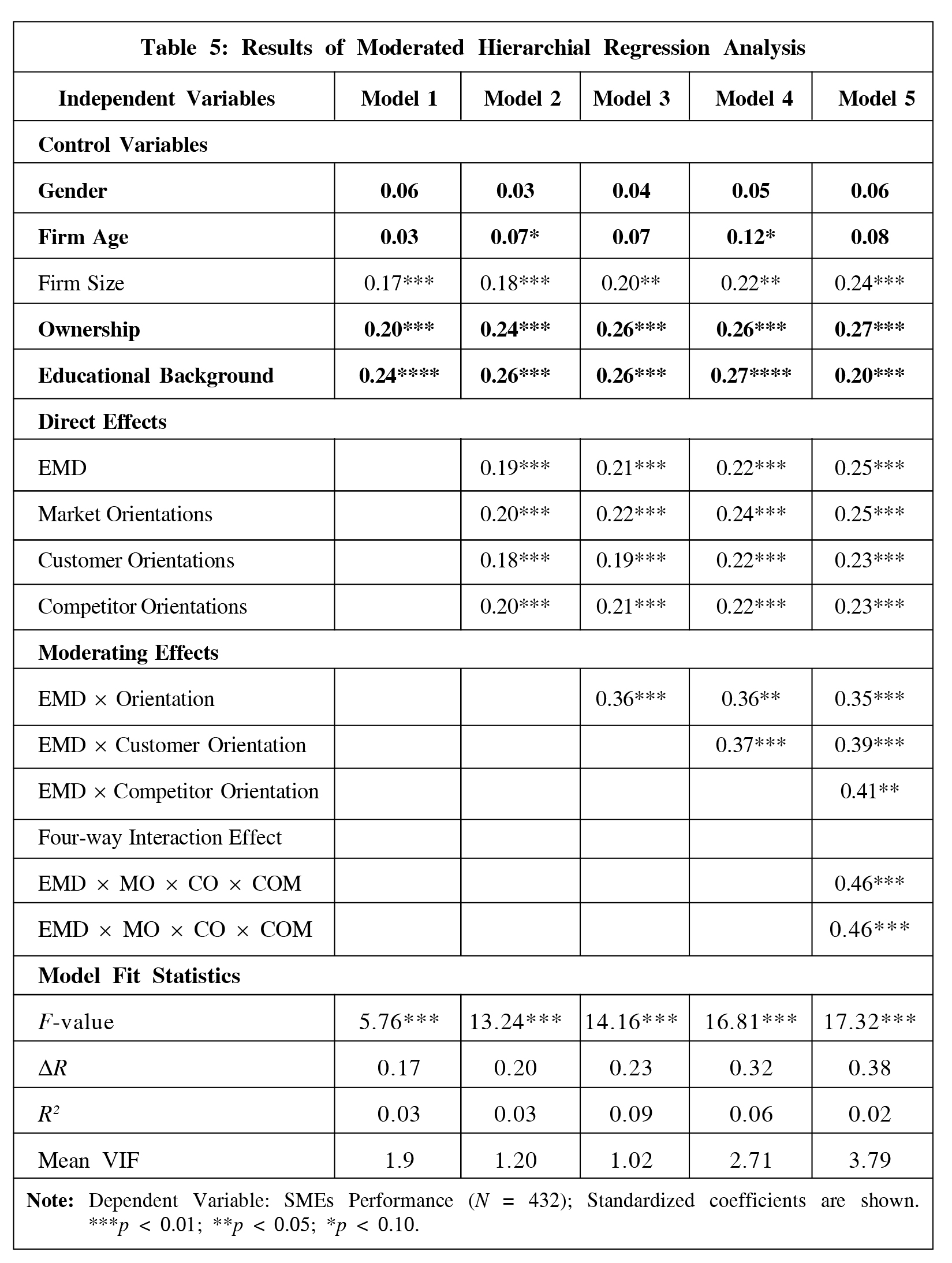
EM philosophy encourages SME market players to use ingenious, and innovative marketing strategies to surpass competition for long-term sustainable growth (Cho and Lee, 2018; Kim et al., 2018; Sadiku-Dushi et al. (2019); and Fard and Amiri, 2018). SMEs in EMs tend to develop products in expectation of growing market and new opportunities, taking into consideration the competition SMEs in EMs have the capacity to deploy requisite resources to fully exploit available market opportunities (Adel et al., 2020; and Mahrous et al., 2020). Proactive SMEs in EMs will achieve their targets in premium segments, move faster to maintain advantage, capitalize a market opportunity for higher returns and remain market leader in performance (Kim et al., 2018; Sadiku-Dushi et al., 2019; and Kalaichelvi and Suganthi, 2020).
Discussion
The main objective of this study is to examine the relationship between EMD, market, customer, competitive orientation and SMEs' business performance in beverages sectors in the emerging market, where it has received little attention. Literature on EMD largely focused on conceptually defining the construct of EMD and examining how it could affect SME performance in the emerging market. This study contributes uniquely to emerging markets, SMEs, beverages sector, RBV theory and entrepreneurship literature.
Entrepreneurship SMEs beverages sector in Ghana, although very promising, is less researched regarding EMD and its implications due to financial and innovations constraints (Sadiku-Dushi et al., 2019; and Kalaichelvi and Suganthi, 2020). Our results are a step toward filling the aforementioned knowledge and theoretical gaps. First, our results indicated that the relationship between EMD, market, customer, competitive orientation and SMEs in emerging market is significantly positive in the Ghanaian. These results are in line with (Adel et al., 2020: Deku et al., 2022; and Mahrous et al., 2020) in the Ghanaian context.
Entrepreneurship SMEs in the beverages sector in EMs adopting EMD achieved satisfactory returns on investment, equity, and assets (Sadiku-Dushi, and Ramadani, 2019; Kalaichelvi and Suganthi, 2020). Moreover, they could achieve fair growth rates in sales, employees, and market share (Adel et al., 2020; and Mahrous et al., 2020). Finally, they were able to generate remarkable return on sales, net profit margins, and gross profit margins (Deku et al., 2021). Adopting EMD and market, customer and competitive orientations in emerging market is seen to be opportunity-driven, and the ability to turn opportunities into reality, accepting risks to gain competitive advantage, being more close to customers and enhancing their satisfaction, and leveraging resources will certainly enhance efficiency, growth, and profit in EMs (Kim et al., 2018; Sadiku-Dushi et al., 2019; Kalaichelvi and Suganthi, 2020). The result is in accordance with the suggested argument of Alqahtani and Uslay, 2020; Adel et al., 2020; Mahrous et al., 2020). The relationship between EMD, market, customers and competitive orientations and SME beverages in EMs performance is stronger in highly business environments (Alqahtani and Uslay 2020; Adel et al., 2020). Under these conditions, SME beverages in EMs needed to conform to the added environmental unpredictability by adopting EMD and MO practices which enabled them to maximize customer and other stakeholder value, improve SME efficiency, take advantage of opportunities and enhance SME growth and profit. And SMEs in EMs need MO to acquire and retain customers (Alqahtani and Uslay, 2020; and Adel et al., 2020).
Implications
This study provides useful managerial, gap, research, teaching, society and practical implications. First, it bridges the knowledge gap between emerging market, EMD, market, customer and competitive orientations and RBV practice by providing modern marketing tool for representing excellent choice for SMEs to improve their competitive landscapes in EMs.
EMD significantly and positively affects SMEs in emerging markets, and SME marketing organizations and national board for Small and medium industries should increase EMD, market, customer and competitive orientations activities to generate more interest in applications of EMD, market, customer and competitive orientations. These campaigns must largely be done through online media platforms due to enhanced technology and because most information is obtained from online sources. SME marketers in emerging markets should include values of EMD, market, customer and competitive orientations in their segmentation as this would refine their offering to enhance the profitability and increase market shares in emerging market. Furthermore, EMD, market, customer and competitive orientations should be included in their marketing activities as these are the most important dimensions that explain market growth and sustainability. The findings of this study appear to suggest that EMD, market, customer and competitive orientations are important factors for the success of SMEs in emerging markets. Hence, it is recommended that the elements of EMD, market, customer and competitive orientations should be included in the plans and policies of SME institutions and policymakers.
Economic Implications: SME owner-managers would achieve excellence by shifting their resources from traditional marketing towards EMD in Ghana as EMs. In commercial EMD, market, customer and completive orientations of Ghana as EMs encourage SMEs to take risks, be able to explore market opportunities, adopt innovativeness to capture opportunities, and exert more effort to maximize customer value.
Body of Knowledge Implications: Our findings encourage employees to identify opportunities, turn problems into opportunities, look beyond current customers and markets, accept a risk to pursue an opportunity, be innovative, build a competitive advantage that is based on understanding customers' needs, and get the resources needed to get the job done.
Public Attitudes Implications: Our findings denied the notion that EMD benefits are limited to SMEs; EMD, market, customer and completive orientation practices should be adopted in all organizations regardless of their objectives and sizes, such as food and beverages which have completely different characteristics from SMEs.
This study contributes to emerging market, SMEs, entrepreneurship literature and RBV theory as follows: First, this study adds to existing literature by examining the relationship between EMD, market, customer and completive orientations and SME performance in the emerging market of Ghana, by empirically testing how EMD enhance SME performance in beverages market. Secondly this study fills considerable knowledge and theoretical gap identified in the RBV between EMD and market, customer and completive orientations in emerging market. Thirdly, this study contributes to RBV theory by using: market, customer and completive orientations, survival, market growth and profitability as pillar. Fourthly, this study has enhanced global understanding of how EMD, market, customer and completive orientations could support beverages operations and improve their performances in emerging market. Lastly, this study shows SMEs in beverages can achieve innovative performances, higher profits, and better production performances and consequently earn higher profits through the applicability of EMD, market, customer and completive orientations.
Conclusion
The study found that market, customer and competitive orientations impact SMEs performance in emerging markets. It is concluded that SME in emerging markets with high EMD, market, customer and competitive orientations are likely to have high profit, increase in their market share, more growth and sustainability. EMD is a non-traditional approach providing business owners/managers tools to efficiently market SME businesses in emerging markets. This study added to emerging market and entrepreneurship literature by testing EMD, market, customer and completive orientations and business performance model of SMEs in beverages sector in Ghana, which has not been empirically tested hitherto. Based on the RBV, we used EMD, market, customer and completive orientations as the measurement of SME performance relationship in emerging markets. The results showed that EMD is positively correlated to SMEs in beverages sector. Also, market, customer and completive orientations have a significant effect on the relationship between EMD and SME performance.
Limitations and Future Scope: This study is not without limitations. First, the study was cross-sectional which can serve as a yardstick for longitudinal and comparative analysis of SME development in emerging markets. The seven EMDs, and market orientations should be measured individually on each dimension. Future research should extend to test the framework using other constructs to measure EMD in large organizations. Second, the study used EMDs and market, customer and competitor orientations as measurement variable of SMEs performance. Future research may use firm's environmental factors such as environmental hostility, complexity, dynamism, and munificence to see if these factors have a significant impact on firm's EMD, market, customer and competitor orientations performance in emerging market. Third, this study focused on beverage SMEs in Ghana. Beverages SMEs in other emerging markets in Africa like Rwanda, Kenya, Nigeria may behave differently due to cultural variability and political and economic policies. Future research should expand this study using cross-national data and replicate the existing results to the same sector or different industries to ensure the generalizability of the current research model. Thus, further research should develop objective measures for these main constructs and streams of research.
References
- Abass A, Sahadah A H and Saad M R (2020), "Moderating Effects of Dynamic Business Environment on the Relationship of Entrepreneurial Orientation and Financial Performance of SMEs", Asian Journal of Multidisciplinary Studies.
- Ahmed M A, Lodhi S A and Ahmad Z (2017), "Political Brand Equity Model: The Integration of Political Brands in Voter Choice", Journal of Political Marketing, Vol. 16, No. 2, pp. 147-179.
- Adams I, Mohammed A K, Wuptigah I J and Ibrahim I (2017), "To Start or to Grow: The Survival Dilemma of Small and Medium Scale Enterprises in Ghana: A Synthesis of Literature", Africa Development and Resources Research Institute (ADRRI) Journal.
- Adel H M, Mahrous A A and Hammad R (2020), "Entrepreneurial Marketing Strategy, Institutional Environment and Business Performance of SMEs in Egypt", Journal of Entrepreneurship in Emerging Economies.
- Ali A, Xaoling G, Sherwani M and Ali A (2018), "Antecedent of Consumers Halal Brand Purchase Intention: An Integrated Approach", Management Decision, Vol. 56, No. 4, pp. pp. 715-735.
- Alqahtani N and Uslay C (2020), "Entrepreneurial Marketing and Firm Performance: Synthesis and Conceptual Development", Journal of Business Research.
- Asante E A and Affum-Osei E (2019), "Entrepreneurship as A Career Choice: The Impact of Locus of Control on Aspiring Entrepreneurs' Opportunity Recognition", Journal of Business Research.
- Awan U K and Kraslawski A (2019), "Corporate Social Responsibility (CSR) Priorities in the Small and Medium Enterprises (SMEs) of the Industrial Sector of Sialkot, Pakistan", Corporate Social Responsibility in the Manufacturing and Services Sectors, Springer.
- Ayuso S and NavarreteBaez F E (2018), "How Does Entrepreneurial and International Orientation Influence SMEs' Commitment to Sustainable Development? Empirical Evidence from Spain and Mexico", Corporate Social Responsibility and Environmental Management.
- Barbu A, Simion P C, Popescu M A et al. (2020), Exploratory Study of the BPM Tools Used by Romanian Industrial Service Companies to Increase Business Performance.
- Battour M, Rahman M K and Rana M S (2019), "The Impact of Phtps on Trip Quality, Trip Value Satisfactions and Word of Mouth", Journal of Islamic Marketing.
- Becherer R C, Helms M M and McDonald J P (2012), "The Effect of Entrepreneurial Marketing on Outcome Goals In SMEs", New England Journal of Entrepreneurship.
- BfT (2020), https://www.todaygh.com/
- Cho Y H and Lee J (2018), "Entrepreneurial Orientation, Entrepreneurial Education and Performance", Asia Pacific Journal of Innovation and Entrepreneurship.
- D'Agostino R (2017), Goodness-of-Fit-Techniques, Vol. 68, Routledge.
- Deku W A, Wang J, Danquah E and Narain D (2021), "Correlation Between Business Innovation Environment (BIE) and Entrepreneurial Orientation Dimension (EOD) on Financial Performance of Manufacturing SMEs in Ghana", World Journal of Entrepreneurship, Management and Sustainable Development, Vol. 17 No. 4, pp. 787-803, available at https://doi.org/10.1108/WJEMSD-09-2020-0117
- Deku W A, Wang J and Das N (2022), "Innovations in Entrepreneurial Marketing Dimensions: Evidence of Halal Food SMEs in Ghana", Journal of Islamic Marketing, ahead-of-print available at https://doi.org/10.1108/JIMA-03-2021-0098
- Dulanjani P A and Priyanath H S (2020), "Intellectual Capital and Business Performance of Self-employers in Sri Lanka: An Empirical Investigation", International Journal of Research and Innovation in Social Science.
- Dzogbenuku K R and Keelson A S (2019), Marketing and Entrepreneurial Success in Emerging Markets: The Nexus, Asia Pacific Journal of Innovation.
- Fard M H and Amiri N S (2018), "The Effect of Entrepreneurial Marketing on Halal Food Smes Performance", Journal of Islamic Marketing.
- Fornell C and Larcker D F (1981), "Evaluating Structural Equation Models with Unobservable Variables and Measurement Error", Journal of Marketing Research, Vol. 18, No. 1, pp. 39-50.
- Ghana Statistical Services (2020).
- Hisrich R D and Ramadani V (2017), Effective Entrepreneurial Management: Strategy, Planning, Risk Management and Organization, Springer International Publishing.
- Jourdan P (2002), Measuring Brand Equity: Proposal for Conceptual and Methodological Improvement, Advances in Consumer Research.
- Kline R B (2015), Principles and Practice of Structural Equation Modeling, Guilford Publications.
- Kim M, Kim J, Sawng Y and Lim K (2018), "Impacts of Innovation Type SME's R&D Capability on Patent and New Product Development", Asia Pacific Journal of Innovation and Entrepreneurship, Vol. 12, No. 1, pp. 45-61.
- Kalaichelvi K and Suganthi U (2020), "Study of Entrepreneurial Marketing of SMEs in Southern Part of Tamilnadu", Sustainable Humanosphere.
- Mahrous A, Genedy M A and Kalliny M (2020), "The Impact of Characteristics of Intra- Organizational Environment on Entrepreneurial Marketing Intensity and Performance in Egypt", Journal of Entrepreneurship in Emerging Economies.
- OECD (2019), Organization for Economic Cooperation and Development-OECD Financing SMEs and Entrepreneurs an OECD Scoreboard.
- Peterson M (2020), "Modeling Country Entrepreneurial Activity to Inform Entrepreneurial- Marketing Research", Journal of Business Research.
- Sadiku-Dushi N, Dana L P and Ramadani V (2019), "Entrepreneurial Marketing Dimensions and SMEs Performance", Journal of Business Research, Vol. 100, p. 1.
- Selase E A and Worlanyo A S (2018), "Challenges and Sustainable Development of Small and Medium-sized Enterprises: Evidence from a Local Processing Company in Ghana (Nkulenu)", Advances in Social Sciences Research Journal.
- Tseng C and Tseng C C (2019), "Corporate Entrepreneurship as a Strategic Approach for Internal Innovation Performance", Asia Pacific Journal of Innovation and Entrepreneurship.